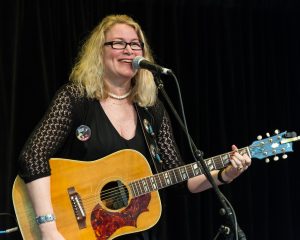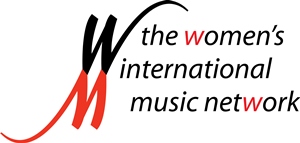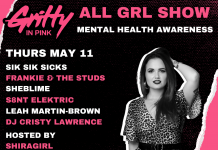Front and Center: Susan Cattaneo, Songwriter, Performer and Professor
By Leslie Buttonow

Photo by Dave Rackley
“I think music might just be the greatest gift we have to share with the world.” This heartfelt statement resides on the website of Susan Cattaneo, a top songwriter in the Boston area, and winner or finalist in nearly a dozen songwriting competitions in recent years. She shares her gift with the world in the form of original songs and performances that feature a smooth blend of rock, folk, blues and country.
This gifted songwriter also encourages others to share their gifts via the songwriting classes she’s taught at Berklee College of Music for 14 years. Cattaneo has an inherent love of listening to songs, talking about songs, and dissecting them to learn what makes them tick and why. Through her classes, she inspires students to develop their own songwriting craft and shares techniques to access the creative mind, overcome writer’s block, and more. Her teaching philosophy reflects a sensible, realistic outlook, namely, “You cannot teach talent. But you can teach someone how to make the most of their talent.”
Below, she shares more of her story as a songwriter, performer and professor. To learn more about Susan Cattaneo, visit susancattaneo.com.
The WiMN: Your original music blends several genres. Tell us about some of your early musical influences and how you developed your own style.
SC: I think my earliest musical influences came from my family. My mother loved musical theater and 1940’s and 1950’s standards, so that’s what I was raised on in New Jersey. I have older sisters and a brother, and we all sing, so we were performing musical theater songs for family and friends from an early age. Imagine the Von Trapps…only from New Jersey!
I also spent most of my summers working on a ranch in Arizona. That’s where I was exposed to country music – the “sing your songs and tell your stories around the campfire” kind of country. There, I fell in love with songs like” Red Headed Stranger” by Willie Nelson and “London Homesick Blues” by Jerry Jeff Walker, and with artists like Emmylou Harris and David Allen Coe. That influence, especially the storytelling part of it, is very present in my own songwriting.
In high school, I loved Joni Mitchell, Crosby Stills and Nash and Carole King, but when I was 17, I was introduced to the music of Bonnie Raitt, and that was a game changer for me. Her music really spoke to me, and her singing style fit my type of voice, so she became one of my favorite musical heroes. When I started to write my own songs, this combination of influences came together to create what I like to call “New England Americana,” which combines my love of image-based lyrics with the musical influences of folk, blues, country and rock.
The WiMN: Early in your career, what are some things you did to develop and polish your songwriting chops?
SC: Writing has always been a constant in my life. I was an English major in college and wrote (and still write) short stories. I was a professional writer as soon as I started working, even though my first job wasn’t songwriting-related at all. Before I made music my full-time career, I lived in NYC and worked in television as a writer/producer by day (and sang in a band at night). Essentially, I made movie trailers and commercials for specific shows that were on different networks. That job required me to do two important things: write every day and write in a short and succinct format. (After all, I only had: 30 or: 60 to tell the whole story). Also, the deadlines were short, and there was a lot of pressure. And in many cases, I had clients who were responding to my scripts with rewrites and revisions. From this process, I learned early on to write quickly and to step away from my ego and learn that creativity can be a fluid and changing thing; that there isn’t always one answer to a lyric line. Sometimes there are many “right” answers.
Musically, I devoured the songs I loved and listened to them over and over, until I knew all the lyrics and could imitate all the artists I was listening to. Once I could sing the song, I would have fun trying to harmonize along with the lead vocals. This helped me develop my ear and also helped me work on my delivery and interpretation of a song.
The WiMN: As a performer, did you ever find it challenging to be a female in a sometimes male-dominated field? If so, how did you handle it?
SC: Oh yes – it is always a challenge to navigate this “man’s world” of music. When I was working in the country market, I found it particularly difficult when country radio wouldn’t (and frankly, still doesn’t) support female artists. It feels like in some areas, we’ve taken a step back, and women’s voices and music are not being heard.
I find this bias doesn’t exist as much in the Americana music community that I’m part of here in Boston. Sure, there are still times when I’ll see a line-up for a festival or show and there is maybe one woman performer on the bill, but I hope that that is changing.
The WiMN: How did your teaching gig at Berklee come about?
SC: We moved to Boston from New York so that my husband could attend business school here, and it just so happened that my brother in law was attending Berklee at the time. I had never heard of the school and was doing music on the side while doing the television writing. After worrying if I were ruining my life, I made the scary decision to quit my paying job and attend Berklee.
I took my first Songwriting class there and discovered that I loved it. I mean, LOVED it. I had a great deal of experience working with writers and editing at that point. I guess I was pretty confident and vocal in my classes about what I would do to make a song more effective. Some students in my classes even asked if I would work with them outside of class.
My mentor, songwriting professor Pat Pattison, was an incredible supporter of mine and kept saying that I’d make a great teacher. When I graduated, he offered me a teaching position, and I’ve been there ever since!
The WiMN: What do you enjoy most about teaching others to enhance their songwriting skills?
SC: I am fortunate enough to work with some very talented people, and I think my greatest joy is when I see them use a new technique we worked on to transform their writing and help them express what they really want to say. It’s pretty wonderful being a catalyst in someone’s creative process, and I’m grateful that I get to play a small role in their artistic development. Also, I think one of my skills as a teacher is that I’m able to explain some of the “magic” that happens in a song and how/why a listener responds to it. Songs are like puzzles to me, and I’m always fascinated and thrilled to share that magic with my students.
The WiMN: Your solo album The Hammer & The Heart is enjoying success on the music charts. Please share some of the inspiration behind the music and the album name, and of course, feel free to brag a bit about how it feels to be “on the charts” with your creation!
SC: OK, I must confess – I am thrilled to have charted with this album! What makes this even more wonderful for me is that these songs are the closest I’ve come to creating something that truly reflects who I am as a person and artist. And it’s crazy, because so many events had to occur or The Hammer & The Heart wouldn’t have happened at all.
Initially, I set out to make “an album.” My concept was that an album allows you to tell a bigger story – something the music industry doesn’t do much these days, since it is so “Single” focused. My fourth record, Haunted Heart, was a really personal and dark album, where I embraced and set free many of the skeletons that had been rattling around in my closet. I had written for other artists, and Haunted Heart was the first time I wrote everything for myself. I didn’t give myself any limitations, and what emerged was a pretty intense album. What also emerged was this beautiful sense of creative freedom both musically and lyrically. Out of this dark writing period, I came around to feeling what a joy it is; this gift of making music.
Haunted Heart also opened a lot of new collaboration doors for me. In the past few years, I have been lucky to perform with (and get great joy from it) many different artists in many different formats, both regionally and nationally. The idea behind this album was to include as many of them as I could. As we were making it, I kept having more song ideas and more artists that I wanted to work with. And right around this time, I decided to really “Go big or go home” and it turned into a double album. There are 41 musicians on this album, including The Bottle Rockets, Bill Kirchen and Mark Erelli! Strangely enough, the songs seemed to divide beautifully into an electric side and an acoustic side.
During this time, I had also had the opportunity to write for and produce an artist named Jenna Lotti (who by the way, is nominated for a Boston Music Award this year!), and because of my experience producing her, I decided that whatever my next project was I wanted to produce it myself.
When I set out to do this album, I had written a song called “Work Hard, Love Harder,” which is pretty much my manifesto for how I feel, and I ended up recording a rock and a folk version of it that starts both sides. The title, The Hammer & The Heart is a visual description of the phrase “Work hard, love harder!”
The WiMN: If our readers would like to check out your music, what are some recommended tracks they should start with, and where can they find them?
SC: I would definitely start with both the rock and folk versions of “Work Hard Love Harder” on The Hammer & The Heart. Other tracks I love on The Hammer side are “In The Grooves” (featuring Bill Kirchen), “The River Always Wins” (with Mark Erelli), “Dry” (with Dennis Brennan), “When Love Goes Right” (with Bill Kirchen). And on The Heart side, I would check out “Fade To Blue” (with Nancy Beaudette) and “Carried” (with Jenee Halstead). I also love my cover of David Bowie’s “Space Oddity” (with Todd Thibaud and Amy Fairchild) on The Heart.
Then, I would go to my album Haunted Heart and listen to the songs “Worth The Whiskey,” “Abide” and “How A Cowboy Says Goodbye.” All the songs can be found on Susancattaneo.com or on Spotify, and other sites like Itunes and Amazon.
The WiMN: Some of our readers will be interested in learning about your side project, The Lucy Stone Singers, and your charitable song, “Sisters of a Different Skin,” as it not only supports female empowerment and equality, but it also raises funds for a good cause. Please share some details.
SC: Earlier this year, I wrote an a cappella song about women’s equality and empowerment called “Sisters of A Different Skin.” When I went to record a quick demo of the song, I kept hearing it in my head as this big anthem-style song, so I kept adding more harmonies.
When I went to actually record the song, I was thinking about the wonderful community of women musicians I know and collaborate with. My idea was to feature as many women of different ages and musical genres that I know in the New England music scene. There were 26 women in total who joined me, representing musical styles from indie, rock, jazz, blues to country, Latin, hip hop and folk. They were amazing, and the song came together beautifully! This experience gave me the confidence that I was on to something important – both creatively and musically – and certainly informed my work on The Hammer & The Heart.
I wanted to have the proceeds go to a charity that benefits women, so we found a non-profit called “Girls Who Code” that teaches young girls tech knowledge and closes the gender gap in that much-needed area. When we were trying to come up with a name for this wonderful group of women, my husband suggested Lucy Stone – she was a suffragist and the first women to get a college degree in Massachusetts. So we’re called The Lucy Stone Singers, and all proceeds from this single go to “Girls Who Code.”
Watch the accompanying video here. For more information or to participate, visit sistersofadifferentskin.com.








